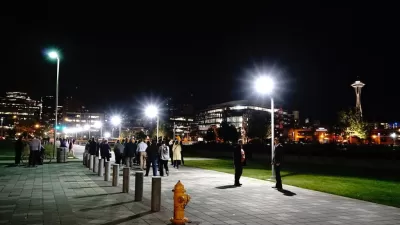Top-down and bottom-up planning are brushed aside in favor of the concept of a middle ground approach in the new book "Fast-Forward Urbanism: Rethinking Architecture's Engagement with the City". It could work, according to this review.
"Fast-Forward Urbanism is based on the proposition that change today occurs as a series of jump-cuts, with effects appearing as if out of nowhere, without any sense of how we got there. The result is a fragmented urbanism that is only understood in retrospect, when historical narratives help piece together the disparate events. The editors propose eight principles of the fast-forward urbanism that call for a "rejiggering" of existing behaviors, encouraging an accumulation of interventions as a means of catalyzing change, and demanding a renewed connection to the local political economy.
The manifesto builds upon the infrastructural outlook of landscape urbanism but articulates a concern for the limited progress that the field has made in urban settings. At a time of unstable economic horizons, the grand gestures of a modernist tradition fail to address specific conditions, while "everyday urbanism" rejects the top-down flow of capital and all-too-readily relinquishes the role of design in shaping cities and stimulating their recovery. Fast-Forward Urbanism seeks to fill in the city's weak spots not with unique projects but with systemic transformations that are neither top-down nor bottom-up and instead negotiate a middle-ground through applied research and the direct interaction of architecture with commercial and political spheres."
Such a prospect could take years or decades to prove itself, but the reviewer finds much hope in the prospect.
FULL STORY: Review> After the City

Planetizen Federal Action Tracker
A weekly monitor of how Trump’s orders and actions are impacting planners and planning in America.

San Francisco's School District Spent $105M To Build Affordable Housing for Teachers — And That's Just the Beginning
SFUSD joins a growing list of school districts using their land holdings to address housing affordability challenges faced by their own employees.

The Tiny, Adorable $7,000 Car Turning Japan Onto EVs
The single seat Mibot charges from a regular plug as quickly as an iPad, and is about half the price of an average EV.

As Trump Phases Out FEMA, Is It Time to Flee the Floodplains?
With less federal funding available for disaster relief efforts, the need to relocate at-risk communities is more urgent than ever.

With Protected Lanes, 460% More People Commute by Bike
For those needing more ammo, more data proving what we already knew is here.

In More Metros Than You’d Think, Suburbs are Now More Expensive Than the City
If you're moving to the burbs to save on square footage, data shows you should think again.
Urban Design for Planners 1: Software Tools
This six-course series explores essential urban design concepts using open source software and equips planners with the tools they need to participate fully in the urban design process.
Planning for Universal Design
Learn the tools for implementing Universal Design in planning regulations.
Smith Gee Studio
City of Charlotte
City of Camden Redevelopment Agency
City of Astoria
Transportation Research & Education Center (TREC) at Portland State University
US High Speed Rail Association
City of Camden Redevelopment Agency
Municipality of Princeton (NJ)





























